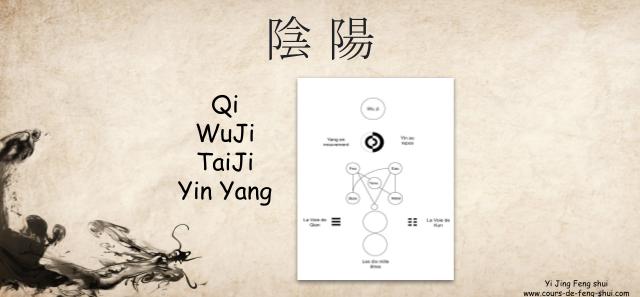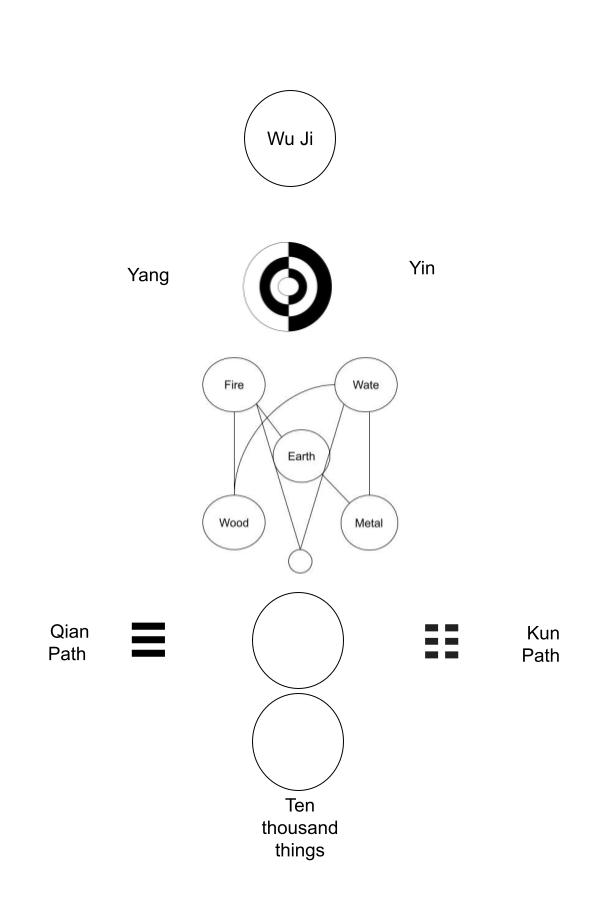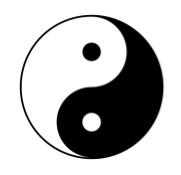
Understanding the forces of nature
Yin and Yang are foundational concepts in Chinese metaphysics, forming the basis of many practices such as Feng Shui, traditional Chinese medicine, Chinese astrology, and numerous other disciplines. These two opposing yet complementary forces are present in everything in the universe, representing the duality inherent in nature. Yin is associated with feminine energy, darkness, cold, and passivity, while Yang is linked to masculine energy, light, heat, and activity. Together, they form a dynamic balance that underlies all existence.

WuJi, TaiJi, and the Creation of the Universe
“For thousands of years, Chinese culture has explored the relationship between WuJi, TaiJi, and Yin-Yang, fundamental concepts that reflect the duality of the universe and the interconnectedness of all things.”
The ancient Chinese said: “Wuji begets Tai Ji, Tai Ji begets Yin Yang”.
WuJi represents the great undifferentiated One, the unconditioned, and is often associated with the Tao in Taoism. It is the state of limitless potential, where everything is unified and undistinguished.
TaiJi is the absolute, a philosophical principle that expresses the duality of Yin and Yang—complementarity, opposition, and the constant transformation from one to the other in an endless cycle. The TaiJi Tu, the symbol of Yin-Yang, illustrates this concept. This diagram, known as the Diagram of the Supreme Pinnacle, represents the original foundation of the universe and embodies the duality and complementarity of Yin and Yang.
Yin-Yang Theory
Yin-Yang is a fundamental concept in Chinese culture that reflects the duality and harmony of the universe. The theory represents the opposition and complementarity of two natural forces found in all things: Yin, symbolizing femininity, darkness, and passivity, and Yang, symbolizing masculinity, light, and activity. Together, they create a dynamic balance that gives rise to everything in the universe. This concept is applied in various fields such as Chinese medicine, astrology, and philosophy. The core idea of the Yin-Yang theory is that these forces are natural, complementary, and contradictory, embodying the principle of opposite polarity and duality. Although different, they complement each other harmoniously. These opposing energies, through their alternation and interaction, gave birth to the universe. Yin and Yang are the bipolar manifestation of the Tao, also known as the Supreme Ultimate, Tai Ji. In essence, they represent Heaven and Earth. From the union of Yin and Yang, the five elements (Wu Xing) were born, forming the foundation for the creation of all beings.
Concept of Qi
The concept of Qi (气), a central element in Chinese culture for thousands of years, is the vital force that animates everything in the universe, from nature to human beings and animals. Qi is considered the foundation of life and is often associated with health, vitality, and longevity.
In traditional Chinese medicine, Qi represents the vital energy that circulates through the meridians in the body. Blockages or imbalances in this energy flow can lead to illness, making the maintenance of harmonious Qi essential for well-being. Qi is also linked to human emotions and the natural world, embodying the Taoist idea of a life force that permeates all things.
The concept of Qi is deeply intertwined with Yin and Yang. According to Taoist philosophy, Qi is the primordial energy that gave rise to the universe. It is the breath of life, the Yuan Qi (元气), which emerged from the undifferentiated WuJi and became divided into Yin and Yang. The mixing of these forces led to the creation of the five elements, or Wu Xing (五行), which in turn gave birth to all phenomena in the universe.
Yin Yang school
The Yin-Yang School (阴阳家), also known as Yin Yang Jia, was a Chinese philosophical school that flourished during the Warring States period. This school sought to explain the universe through the interplay of Yin and Yang energies, a concept that was later expanded to include the theory of the five elements. Practitioners of this school were often sky observers and calendar makers, as documented in ancient Chinese historical records.
During the Han dynasty, the scope of Yin-Yang theory was broadened, incorporating the five elements to explain the processes of the natural world. This integration of Yin-Yang with Wu Xing became a key framework for understanding Chinese cosmology, influencing fields as diverse as medicine, astrology, and Feng Shui.

Tai Ji Tu symbol
The Tai Ji Tu symbol, commonly known as the Yin-Yang symbol, represents the duality and complementarity of Yin and Yang. It is a cosmological diagram that illustrates the creation of the universe from the Supreme One, or Tai Ji, which is identified with WuJi. The diagram shows the cyclical nature of Yin and Yang, where each force contains the seed of its opposite, ensuring continuous transformation and balance.
In this symbol, the outer circle represents WuJi, the undifferentiated whole. The black and white halves represent Yin and Yang, with a small dot of the opposite color in each half, signifying that nothing is ever purely Yin or Yang—each contains the potential for the other. The S-shaped line between them symbolizes the dynamic movement and interaction of these forces.
The Tai Ji Tu encapsulates the essence of Chinese metaphysical thought, where opposites are not in conflict but in a harmonious dance, each giving rise to the other in an eternal cycle of change.
Yin Yang concepts
Several key concepts define the Yin-Yang theory:
- Change and Transformation: Yin transforms into Yang, and Yang transforms into Yin, as day turns into night and night into day.
- Opposition: Yin and Yang are relative opposites, such as winter (cold) and summer (hot).
- Interdependence: One cannot exist without the other; Yin cannot exist without Yang, and Yang cannot exist without Yin.
The Origins of Yin and Yang in Chinese Characters

Examining the ideograms for Yin and Yang provides insight into their conceptual origins:
Traditional Chinese Ideograms
- 阴 (Yin): Represents a forming storm, with symbols for clouds and accumulation.
- 阳 (Yang): Represents a dissipating storm, with symbols for the sun and sun’s rays.
Modern Chinese Ideograms
- 阳 (Yang): Represents the sun.
- 阴 (Yin): Represents the moon.
Conclusion
The theory of Yin-Yang is a profound and all-encompassing philosophy that reflects the balance and harmony of the universe. It is a dynamic system where opposites coexist, interact, and transform into each other, maintaining the equilibrium of all things. From this interplay of Yin and Yang, the five elements were born, laying the foundation for all creation.
Understanding Yin and Yang is key to grasping the broader principles of Chinese metaphysics, as it underpins practices such as Feng Shui, traditional Chinese medicine, and astrology, shaping the way these ancient disciplines approach the natural world and human life.